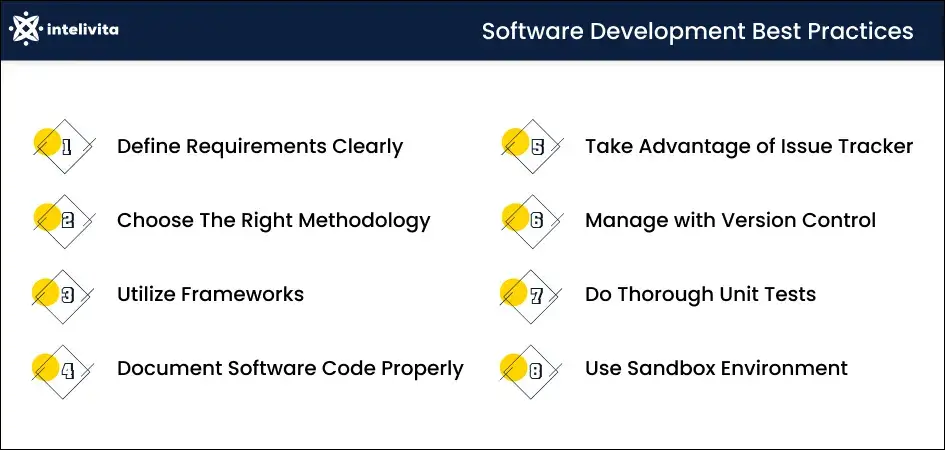Looking to build better software?
You’ve come to the right article, as we’re going to explore 8 software development best practices.
These best practices are a set of guidelines and principles to improve the quality, efficiency, and security of the developers’ work.
By following the development best practices, you can avoid common pitfalls and produce software that is more reliable, maintainable, and user-friendly.
Let’s dive in!
Why Are Software Development Best Practices Important?
The best software development practices are essential guidelines that underpin successful software engineering projects.
They offer multiple benefits:
- Better Quality: Following these practices helps ensure reliable, bug-free, and user-friendly software.
- Efficiency Boost: They can speed up development, meet deadlines and save resources.
- Cost Savings: By avoiding common problems, projects become more cost-effective.
- Improved Security: Best practices help software become less vulnerable to cyber threats, safeguarding both the application and its users.
8 Software Development Best Practices Every Programmer Should Know
Let’s explore the software best practices below.
#1. Define Requirements Clearly
Requirements are the blueprint for software projects.
They describe what the software should do, how it should work, and what users should expect. Clear requirements are essential for successful software development.
To define requirements clearly, gather input from all stakeholders, including users, customers, and business analysts.
This ensures that the requirements are complete and accurate, and that they meet the needs of all stakeholders.
One way to document requirements is to create a Software Requirements Specification (SRS) document.
The SRS includes software requirements and design specifications, and ensures that requirements are met, and processes are followed.
For example, if you are developing software for a bank, the SRS might include requirements for these features:
- Checking account balances
- Transferring money between accounts
- Depositing checks
- Paying bills
- Securely storing customer data
The SRS should also include any specific requirements for document management and security, such as user authentication.
#2. Choose The Right Methodology
There are various software development methods like agile and waterfall.
The choice of methodology depends on the project’s nature and the desired outcome.
For instance, agile development is a flexible approach that focuses on teamwork and continuous improvement.
It breaks projects into smaller parts, making it easy to adapt to changing needs. It’s great for projects like web or mobile apps that need regular updates.
Meanwhile, waterfall is a structured, linear method. It’s best when requirements don’t change much during the project.
Ideal for projects with clear goals and strict deadlines, like building business landing page websites.
Some considerations when choosing the right methodology are:
- Requirements Flexibility: Start by evaluating the project’s requirements. Determine whether they are likely to change during development, as this can significantly impact your choice.
- Project Size: Consider the scale of the project. Some methodologies are better suited for larger projects, while others are more efficient for smaller ones.
- Time Constraints: Check whether the project is under strict time constraints and you need to get it to market quickly, as some methods are better for tight deadlines.
#3. Utilize Frameworks
Frameworks provide pre-built code and functionality that software developers can use to build their applications.
By integrating frameworks, software developers can streamline their work, reduce development time, and ensure software quality.
Note that various frameworks cater to different programming languages and platforms.
When choosing a framework, consider your project’s needs and your team’s skills.
Here’s a checklist to help you pick the right framework:
- Programming Language: Opt for a framework that aligns with your chosen programming language. This compatibility ensures seamless integration.
- Project Requirements: Tailor your framework choice to your project’s unique needs, including features, project size, and complexity.
- Security: Prioritize the security and reliability of the framework. Ensure it offers strong security features and the scalability to accommodate your user base.
- Feature Set: Confirm that it possesses all the necessary features for your project, both now and in the future. It should align with your project’s vision.
- Performance: Gauge the framework’s ability to handle your project’s workload while delivering efficiency to users.
- Documentation: Choose a framework with comprehensive documentation. Effective documentation simplifies the learning curve and accelerates your development process.
- Community Support: Look for frameworks with robust and active communities. A vibrant community ensures you’ll have the help and support you need.
#4. Document Software Code Properly
Properly documenting your software code is essential for understanding, maintaining, and updating it. It also aids new software developers in grasping your project quickly.
To write effective code documentation, consider these tips:
- Be Clear and Concise: Use plain language that everyone can understand. Explain what the code does, how it works, and why it’s written this way.
- Use Different Documentation Styles: Include comments, inline documentation, and external documentation.
Here are specific items to document:
- README File: Provide a project description, installation instructions, and a brief example or tutorial.
- Issue Tracker: Allow reporting issues with your code.
- Application Programming Interface (API) Documentation: Detail your APIs, explaining what each function does, its parameters, and what it returns.
- Coding Conventions: Follow conventions for file organization, comments, naming, and coding practices.
- Contributors: Offer information for contributors, such as how to submit pull requests.
- Citation Information: Cite any third-party code or libraries you use.
- Licensing Information: Specify the license for your code.
#5. Take Advantage of Issue Tracker
An issue tracker is a system that records and manages all the problems users encounter with your software.
It enables support agents, engineers, and managers to monitor these issues until they’re successfully resolved.
Issue tracking software helps software developers report and track issues early, preventing them from becoming bigger problems.
Furthermore, it also provides transparency for everyone working on the project, allowing them to see what’s being worked on and what issues need to be addressed.
You can try issue tracker tools like Zendesk, ClickUp, and GitLab.
#6. Manage with Version Control
Version control is a system for tracking and managing changes to software code.
These allow software developers to keep track of different versions of their code, and to revert to previous versions if necessary.
Version control systems are essential for any software project, regardless of the size or complexity of the project. Here’s how version control can help your team:
- Collaborating on a Feature: Version control lets developers work on the same feature without causing conflicts.
- Undoing Mistakes: If a developer makes a mistake, they can quickly go back to a previous code version.
- Finding and Fixing Bugs: Version control helps identify the code change that caused a bug.
- Combining Changes from Different Branches: Developers can merge changes from various branches.
This is handy for when multiple developers are working on features or when testing features before adding them to the main code.
There are a number of different version control systems available, such as Git and SVN.
#7. Do Thorough Unit Tests
Unit testing involves assessing individual code components to verify their functionality.
Benefits of thorough unit testing include:
- Early bug detection and resolution
- Enhanced code quality and maintainability
- Cost reduction in software development
- Increased customer satisfaction
Remember, don’t limit testing to scenarios where everything works smoothly. Intentionally create tests that trigger failures to see how your code responds.
For example, if your software expects a list of items, test what happens when a user enters just one item. Does the application handle it gracefully, display an error message, or crash?
You should aim for complete test coverage across your code.
Additionally, use code coverage tools to gauge the extent of code covered by unit tests, highlighting areas that need further scrutiny.
Some popular tools are Parasoft Jtest, CodeCover, and Istanbul.
Leveraging code coverage tools ensures a comprehensive code examination, ultimately enhancing your software’s reliability and quality.
#8. Use Sandbox Environment
In software development, sandboxing is a method that isolates code.
This keeps code away from unauthorized resources and minimizes potential damage caused by bugs or vulnerabilities.
This isolation technique contains software within a protected environment, segregating it from the main system.
Here are the advantages of sandboxing:
- Enhanced Security: Sandbox environments effectively shield the system from potentially harmful, malicious code. This isolation prevents unauthorized access and tampering.
- Resource Access Control: Sandboxing ensures software only accesses authorized resources, reducing the risk of data breaches and enhancing overall system security.
- Optimized Software Performance: By isolating software, sandboxing can improve overall system performance. It prevents resource conflicts and ensures applications run smoothly.
- Streamlined Development and Testing: Sandboxing simplifies the development and testing processes by offering a secure, controlled environment to create and assess software.
This minimizes potential risks and errors in the development stage.
Takeaways
In this article, we’ve learned that:
- Embracing software development best practices helps create efficient, secure, and high-quality software.
- Clear requirements, the right methodology, frameworks, effective code documentation, issue tracking, version control, thorough unit testing, and code coverage tools are all vital components of successful software development.
- These practices collectively lead to cost savings, enhanced security, and improved customer satisfaction.
By following these guidelines, developers can avoid common pitfalls and deliver reliable, maintainable, and user-friendly software products.
If you’re looking for a software development agency that implements best practices on your projects, consider Intelivita.
We’re a leading provider with over 600 successful projects delivered.






